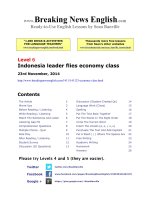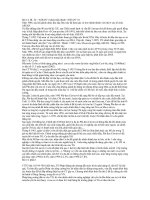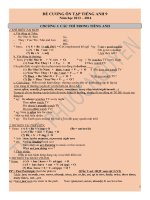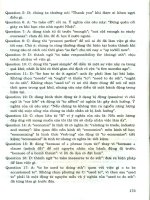Ôn tập Tiếng Anh khối 10
Bạn đang xem bản rút gọn của tài liệu. Xem và tải ngay bản đầy đủ của tài liệu tại đây (112.54 KB, 8 trang )
<span class='text_page_counter'>(1)</span><div class='page_container' data-page=1>
<i><b>Exercise 1. Read the following passage and mark the letter A, B, C, or D to indicate the </b></i>
<i><b>correct answer to each of the questions.</b></i>
For Catherine Lumby, deciding to take on the role of breadwinner in her relationship was not a
difficult choice. When she discovered she was pregnant with her first child, she had just been
offered a demanding new role as Director of the Media and Communications department at the
University of Sydney. But she didn't see this as an obstacle, and was prepared to use childcare
when the children were old enough. It came, therefore, as a surprise to Lumby and her husband
Derek that, after the birth of their son, they couldn’t actually bear the thought of putting <b>him into</b>
childcare tor nine hours a day. As she was the one with the secure job, the role of primary
care-giver fell to Derek, who was writing scripts for television. This arrangement continued for the
next four years, w ith Derek working from home and caring for both of their sons. He returned to
full-time work earlier this year. Whilst Lumby and her husband are by no means the only
Australians making such a role reversal, research suggests that they are in the minority. In a
government-funded survey in 2001, only 5.5 percent of couples in the 30-54 year age group saw
the women working either part- or full-time while the men were unemployed.
The situation is likely to change, according to the CEO of Relationships Australia, Anne
Hollonds. She suggests that this is due to several reasons, including the number of highly
educated women in the workforce and changing social patterns and expectations. However, she
warns that for couples involved in role-switching, there are many potential difficulties to be
overcome. For men whose self-esteem is connected to their jobs and the income it provides to
the family, a major change of thinking is required. It also requires women to reassess,
particularly with regard to domestic or child-rearing decisions, and they may have to learn to
deal with the guilt of not always being there at key times for their children. Being aware of these
issues can make operating in non-traditional roles a lot easier.
1. What is the main idea of the passage?
A. Men being the bread winners B. Traditional roles of women
C. Women being the home makers D. Reversed roles between men and women
2. Catherine and her husband decided that Catherine would be the primary earner because ____.
A. she had a badly paid job B. she was not good at childcare
C. she had a reliable job D. she wanted her husband to stay at home
3. In paragraph 1, the word “him" refers to ____.
A. their son B. her husband C. Derek D. her colleague
4. They decided that Derek would look after their son because they ____.
</div>
<span class='text_page_counter'>(2)</span><div class='page_container' data-page=2>
D. worried about their son’s health problems
5. In paragraph 2, the word “reversal" is closest in meaning to ____.
A. stability B. modification C. rehearsal D. switch
6. One reason tor a change in the number of men staying home is ____.
A. the stability in the number of highly-educated women who are working
B. the fall in the number of highly-educated women who are working
C. the rise in the number of highly-educated women who are working
D. the fluctuation in the number of highly-educated women who are working
<i><b>Exercise 2. Read the following passage and mark the letter A, B, C, or D to indicate the </b></i>
<i><b>correct answer to each of the questions.</b></i>
In 1812 a young man called James Barry finished his studies in medicine at Edinburgh
University. After graduating he moved to London where he studied surgery at Guy’s Hospital.
After that the popular young doctor joined the army and over the next forty years had a brilliant
career as an army medical officer, working in many far-off countries and fighting successfully
for improved conditions in hospitals. It was a remarkable career - made even more remarkable
by the discovery upon his death that <i>he</i> was in fact a <i>she</i>, James Barry was a woman.
No one was more surprised at this discovery than her many friends and colleagues. It was true
that throughout her life people had remarked upon her small size, slight build and smooth pale
face. One officer had even objected to her appointment as a medical assistant because he could
not believe that Barry was old enough to have graduated in medicine. But no one had ever
seriously suggested that Barry was anything other than a man.
By all accounts Barry was a pleasant and good-humoured person with high cheekbones, reddish
hair, a long nose and large eyes. She was well-liked by her patients and had a reputation for great
speed in surgery - an important quality at a time when operations were performed without
anaesthetic. She was also quick tempered. When she was working in army hospitals and prisons
overseas, the terrible conditions often made her very angry. She fought hard against injustice and
cruelty and her temper sometimes got her into trouble with the authority. After a long career
overseas, she returned to London where she died in 1865. While the undertaker’s assistant was
preparing her body for burial, she discovered that James Barry was a woman.
So why did James Barry deceive people for so long? At that time a woman could not study
medicine, work as a doctor or join the army. Perhaps Barry had always wante to do these things
and pretending to be a man was the only way to make it possible. Perhaps she was going to tell
the truth one day, but didn’t because she was enjoying her life as a man too much. Whatever the
reason, Barry's deception was successful. By the time it was discovered that she had been the
first woman in Britain to qualify as a doctor, it was too late for the authorities to do anything
about it.
</div>
<span class='text_page_counter'>(3)</span><div class='page_container' data-page=3>
A. Gender discrimination among doctors in London
B. James Barry pretended to be a man to become a doctor
C. James Barry and her career overseas
D. Punishment for James Barry’s deception
2. In paragraph 1, the word “remarkable" is closest in meaning to ____.
A. noticeable B. commented C. rewarding D. focused
3. According to the passage, all of the following are true EXCEPT .
A. all people were surprised at the discovery
B. people remarked upon her small size
C. many people suspected that she was a woman
D. people noticed her slight build and smooth pale face
4. In paragraph 2, the word “objected" is closest in meaning to ____.
A. shared B. agreed C. protected D. protested
5. According to the passage, which of the following is TRUE about James Barry?
A. She could control her temper perfectly. B. She lost her temper easily.
C. She never lost her temper. D. She was calm and well-behaved.
6. According to the passage, which of the following is TRUE about James Barry?
A. She performed her operations quickly. B. She performed her operations slowly.
C. She performed her operations carelessly. D. Her patients did not like her very much.
7. In paragraph 4, the word “it" refers to ____.
A. Barry's choice B. Barry’s career C. Barry’s deception D. Barry's reputation
<b>Exercise 3: </b>
A pioneer leader for women’s rights, Susan Anthony became one of the leading women
reformers of the 19th<sub> century. In Rochester, New York, she began her first public crusade on</sub>
behalf of temperance, the habit of not drinking alcohol. The temperance movement dealt with the
abuses of women and children who suffered from alcoholic husbands. Also, she worked
tirelessly against slavery and for women’s rights. Anthony helped write the history of woman
suffrage.
</div>
<span class='text_page_counter'>(4)</span><div class='page_container' data-page=4>
Anthony did not work alone. She worked with reformers of women’s rights such as Elizabeth
Cady Stanton and Amelia Bloomer. Susan worked for the American Anti-Slavery Society with
Frederick Douglas, a fugitive slave and black abolitionist.
On July 2nd<sub> 1979, the US Mint honored her by issuing the Susan Anthony dollar coin.</sub>
Although Anthony did not live to see the fruits of her efforts, the establishment of the 19th
Amendment is indebted to her efforts, according to US historians.
1. Anthony advocated all of the following EXCEPT .
<b>A. slavery should be abolished</b>
<b>B. women are citizens and should have the right to vote</b>
<b>C. employers should provide childcare for female employees</b>
<b>D. alcohol should be prohibited because of the abuse it causes</b>
2. The underlined word “crusade” in paragraph 1 is closest in meaning to .
<b>A. a battle against authority</b>
<b>B. campaign to work tirelessly for one’s beliefs</b>
<b>C. a war against the enemies in the Middle Ages</b>
<b>D. an attempt to fight evil</b>
3. What would historians say about Susan Anthony’s greatest achievement?
<b>A. She was an activist and raised a family at the same time.</b>
<b>B. She worked with abolitionists to get the country rid of slavery.</b>
<b>C. Her tireless efforts to guarantee women the right to vote led to the establishment of the</b>
19th<sub> Amendment to the Constitution.</sub>
<b>D. Women had the legal right to vote under the provisions of the 14</b>th<sub> and 15</sub>th<sub> Amendments</sub>
to the Constitution.
4. In which of the following ways did the US Mint honor her life’s work?
<b>A. The Susan Anthony stamp was issued.</b>
<b>B. The Susan Anthony dollar coin was issued.</b>
<b>C. The Susan Anthony Memorial Park was built in Rochester.</b>
<b>D. Susan Anthony dolls were created.</b>
5. What is the main idea of the passage?
<b>A. Slavery was one of Susan Anthony’s causes.</b>
<b>B. Susan Anthony did not accept the use of alcohol.</b>
<b>C. Susan Anthony never gave up her struggle for all people’s freedom.</b>
<b>D. Reformers do not always see the results of their efforts.</b>
Exercise 4. <b>Read the passage, and choose the correct answer A, B, C or D for each</b>
<b>question.</b>
</div>
<span class='text_page_counter'>(5)</span><div class='page_container' data-page=5>
money on travel abroad and shopping. Housewives are active in networking themselves for
various objectives, for example volunteer activities, community services, recycling activities,
study groups, and many others. The traditional Japanese value of “good wife, good mother’ is
changing.
Unlike other countries where a couple is the usual social unit, in Japan it is typical for only
the husband to be invited to business gatherings or to weddings for company employees.
Exceptions are frequently made for foreign visitors depending on the occasion, but wives should
not take their exclusion as a personal insult.
1. The status of women in Japan is .
<b>A. indefinite and illegal</b> <b>B. complex and unclear</b>
<b>C. clear and high</b> <b>D. low and simple</b>
2. Nowadays. Japanese women .
<b>A. can go to work after getting married and having children</b>
<b>B. all have become professional women</b>
<b>C. take over most important work in many companies</b>
<b>D. have the same work and pay as men in all companies</b>
3. In the family, the female partner .
<b>A. often does all the housework if she doesn’t go to work</b>
<b>B. the male spouse always helps his wife with cooking and other chores</b>
<b>C. is still generally expected to do all of the housework</b>
<b>D. no longer spends much time doing the housework</b>
4. Which of the following sentences is NOT true according to the passage?
<b>A. It is normal for only the husband to be invited to business gatherings.</b>
<b>B. Single Japanese women are used to enjoying their lives, spending much money on travel</b>
abroad and shopping.
<b>C. The traditional Japanese value of “good wife, good mother” is changing.</b>
<b>D. Wives in Japan can take their exclusion as a personal insult.</b>
5. What can be inferred from the passage is .
<b>A. the role of Japanese women in the society is changing so that all Japanese women gain</b>
gender equality in both society and home
<b>B. there have been some changes in their social role but Japanese women haven’t acquired</b>
the same rights as men in many fields yet
<b>C. Japanese women are fighting for their definite status in the society</b>
<b>D. most Japanese women are satisfied with their social role nowadays</b>
<b>V. Choose the word or phrase among A, B, C or D that best fits the blank space in the</b>
<b>following passage.</b>
<b>Saudi Women Register To Vote For The First Time</b>
</div>
<span class='text_page_counter'>(6)</span><div class='page_container' data-page=6>
last month. (3) the legal barrier to voting has been lifted, other Saudi laws and culture
could complicate women’s (4) to cast their votes.
Saudi women still have to deal with limits on their freedom of movement, and since it’s
illegal for them to drive, many of them will have to (5) male members of their
family to take them to register and to vote. Male relatives who oppose female voting rights could
also be a barrier. The government also (6) voters to have personal ID cards, and many
Saudi women do not.
To make serious (7) on women’s rights, Saudi authorities should 8) the
male guardianship system, under which caring policies and practices (9) women from
obtaining a passport, marrying, traveling, or accessing higher education without the approval of a
male guardian. Only then will Saudi Arabia's women be able to (10) to society on an equal
situation with men.
1. <b>A. life</b> <b>B. history</b> <b>C. campaign</b> <b>D. period</b>
2. <b>A. take place</b> <b>B. take part</b> <b>C. take care</b> <b>D. take after</b>
3. <b>A. When</b> <b>B. Because</b> <b>C. However</b> <b>D. While</b>
4. <b>A. work</b> <b>B. careers</b> <b>C. efforts</b> <b>D. travels</b>
5. <b>A. trust</b> <b>B. remain</b> <b>C. base on</b> <b>D. rely on</b>
6. <b>A. needs</b> <b>B. keeps</b> <b>C. requests</b> <b>D. requires</b>
7. <b>A. development</b> <b>B. steps</b> <b>C. progress</b> <b>D. movement</b>
8. <b>A. cut</b> <b>B. stop</b> <b>C. complete</b> <b>D. finish</b>
9. <b>A. prevent</b> <b>B. take</b> <b>C. end</b> <b>D. remove</b>
</div>
<span class='text_page_counter'>(7)</span><div class='page_container' data-page=7></div>
<span class='text_page_counter'>(8)</span><div class='page_container' data-page=8>
<b>Answer </b>
Exercise 1:
1. D 2. C 3. A 4. B 5. D 6. C
Exercise 2:
1.B 2. A 3. C 4. D 5. B 6. A 7. C
Exercise 3:
1. C 2. B 3. C 4. B 5.C
Exercise 4:
1. B 2. A 3. C 4. D 5.B
Ex 5
</div>
<!--links-->









